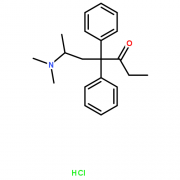CH3ClO

1.熔点(ºC):232-234
2.闪点(ºC):11
3.性状:白色结晶性粉末
4.溶解性(g/100ml):水12,乙醇8,异丙醇2.4;几乎不溶于醚、甘油。
1.熔点(ºC):232-234
2.闪点(ºC):11
3.性状:白色结晶性粉末
4.溶解性(g/100ml):水12,乙醇8,异丙醇2.4;几乎不溶于醚、甘油。
1.疏水参数计算参考值(XlogP):无
2.氢键供体数量:1
3.氢键受体数量:2
4.可旋转化学键数量:7
5.互变异构体数量:2
6.拓扑分子极性表面积20.3
7.重原子数量:24
8.表面电荷:0
9.复杂度:346
10.同位素原子数量:0
11.确定原子立构中心数量:0
12.不确定原子立构中心数量:1
13.确定化学键立构中心数量:0
14.不确定化学键立构中心数量:0
15.共价键单元数量:2